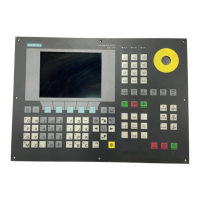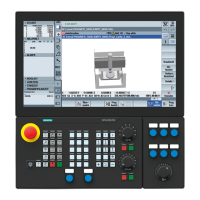W1: Tool offset
18.6 Toolholder with orientation capability
Basic Functions
Function Manual, 09/2011, 6FC5397-0BP40-2BA0
1515
MD20184 $MC_TOCARR_BASE_FRAME_NUMBER (Number of the basic frames for taking the table offset)
Activation of kinematic type M
With kinematics of type M (tool and table are each rotary around one axis), the activation of a toolholder with
TCARR simultaneously produces a corresponding change in the effective tool length (if a tool is active) and the
zero offset.
Rotations
Depending on the machining task, it is necessary to take into account not only a zero offset (whether as frame or
as tool length) when using a rotary toolholder or table, but also a rotation. However, the activation of a toolholder
with orientation capability never leads directly to a rotation of the coordinate system.
TOROT
If only the tool can be rotated, a frame whose Z axis points in the direction of the tool can be defined with
TOFRAME or TOROT.
PAROT
If the coordinate system needs to be fixed relative to the workpiece, i.e. not only offset relative to the original
position but also rotated according to the rotation of the table, then PAROT can be used to activate such a rotation
in a similar manner to the situation with a rotary tool.
With PAROT, the translations, scalings and mirrorings in the active frame are retained, but the rotation component
is rotated by the rotation component of a toolholder with orientation capability corresponding to the table.
PAROT and TOROT take into account the overall change in orientation in cases where the table or the tool are
oriented with two rotary axes. With mixed kinematics only the corresponding component caused by a rotary axis
is considered. It is thus possible, for example, when using TOROT, to rotate a workpiece such that an oblique
plane lies parallel to the XY plane fixed in space, whereby rotation of the tool must be taken into account in
machining where any holes to be drilled, for example, are not perpendicular to this plane.
Language command PAROT is not rejected if no toolholder with orientation capability is active. This causes no
changes in the programmed frame.
Note
For more information about the TCARR and TOROT functions, as well as PAROT in relation to
channel-specific system frames, please refer to:
References:
/FB1/ Function Manual, Basic Functions; Axes, Coordinate systems, Frames (K2).

